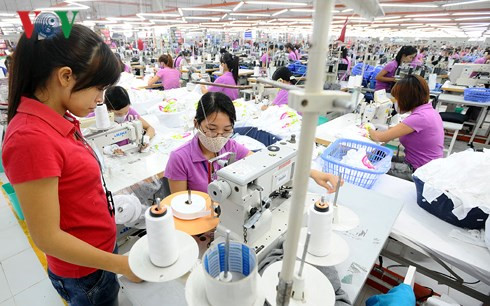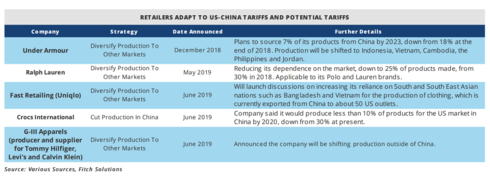Trade war to benefit Vietnam’s fashion sector
Mon, 01 Jul 2019 15:03:00 | Print | Email Share:
VOV.VN - Vietnam and Bangladesh are forecast to reap benefits from becoming alternative sourcing destinations as the fashion sector is reckoned the most exposed amid an escalating US - China trade war with the US tariff threat of additional US$300 billion of Chinese imports, according to Fitch Solutions analysts.

Both Vietnam and Bangladesh appear to be well-positioned as clothing manufacturing
hubs and will be obvious choices as clothing retailers with exposure to the US shift
their production out of China. (Illustrative photo: VOV)
US President Donald Trump has most recently threatened to levy new tariffs on US$300 billion worth of Chinese imports to the US. Unlike previous rounds of tariffs that largely targeted industrial and commercial products, this round is expected to cover all US imports from China and hit consumer goods such as toys, footwear, and apparel.
Fitch Solutions, a macro research unit of Fitch Group, noted that on May 5 President Donald Trump announced the US would increase tariffs on US$200 billion worth of Chinese goods to 25 per cent, a rise from 10 per cent. In response, China reacted by imposing tariffs of between 5 and 25 per cent on US$60 billion of US goods.
A study by the US’ National Retail Federation shows that the threatened US$300 billion in tariffs would cost US consumers an additional US$12.2 billion each year, with apparel (US$4.4 billion), footwear (US$2.5 billion), toys (US$3.7 billion), and household appliances (US$1.6 billion).
Currently, finished clothing and footwear have been excluded from the list, but if President Trump makes good on his threat to raise tariffs on US$300 billion worth of Chinese products, the impact on the consumer would be immediately felt.
The US remains highly dependent on the Chinese market for clothing and footwear, with almost 40 per cent of its imports coming from the Asian giant. US imports of China-made clothing and footwear rose by 1 per cent on year in 2018, reaching US$44.1 billion. In the footwear industry alone, the US imports 53 per cent of its total footwear from China.
Clothing and footwear manufacturers to benefit
American companies are already reacting to existing planned tariffs and their impact on supply chains by decreasing their reliance on China and seeking new markets to source from. For instance, Crocs International has reduced its China production levels for goods bound for the US market whilst both Ralph Lauren and Uniqlo have begun to diversify their supply chains towards options outside China.

Fitch Solutions analysts unveiled that Fast Retailing, which owns brands including Uniqlo and J Brand, is trying to mitigate the impact of the trade war on its operations in the US.
Fast Retailing has been pursuing a strategy to launch discussions on increasing its reliance on South and Southeast Asia nations such as Bangladesh and Vietnam for the production of clothing, which is currently exported from China to its US outlets.
The US is becoming an important market for Fast Retailing and the company is therefore seeking to avoid the damage an increase in price (an obvious implication of tariffs) would have on the company’s engagement with US consumer’s purchasing patterns.
Fast Retailing has nearly doubled the footprint for its Uniqlo brand in the US market, with the store count reaching 52 as of May 2019, a rise from 25 in late August 2014. As a result, the US is quickly becoming the largest market in North America and Western Europe for Uniqlo by store count.
The Vietnamese and Bangladeshi markets have been identified by Fast Retailing as already locations where the company sources its products from, along with Indonesia. Increasing their reliance on Vietnam and Bangladesh would make strategic sense as the firm already has existing relationships with manufacturers, meaning strengthening the bonds will be easier than finding a new market for production.
In fact, the enterprise has already tried to increase their sourcing from Vietnam, with the number of suppliers in the country increasing by 40 per cent between February 2017 and February 2018.
Well placed to benefit from trade war
Both Vietnam and Bangladesh appear to be well-positioned as clothing manufacturing hubs and will be obvious choices as clothing retailers with exposure to the US shift their production out of China. Indeed, following China, the two countries are the biggest exporters for articles of clothing knitted and non-knitted globally.
Global clothing exports reached US$30.3 billion for Vietnam and US$36.9 billion for Bangladesh during 2018, according to data released by Trade Map. This puts them ahead of other clothing manufacturers in the region such as India, where global clothing exports hit only US$15.7 billion in the same year.
Fast Retailing’s expansion of their supply chain in Vietnam and Bangladesh is a logical move as the company has already nurtured existing relationships with suppliers there. Fitch Solutions has highlighted three reasons why, even without the ongoing trade war, retailers are starting to look beyond China for their fashion sourcing needs.
Cost points are a clear and obvious reason as lower wages in South and Southeast Asia prompted numerous retailers to lower their production levels in China long before the trade war came into play. Minimum wages in Vietnam and Bangladesh are US$125 - 180 and US$95 respectively, much lower than the US$250 - 300 level seen in China, according to National Sources for 2019.
Secondly, both Vietnam and Bangladesh enjoy preferential trade access to key clothing markets. Vietnam for instance is expected to sign a free trade agreement with the EU, which would create considerable opportunities for the garment and footwear export industries, with taxes poised to slide to zero per cent. In addition, the Vietnamese textile sector will also benefit from access to member countries of the Comprehensive and Progressive Agreement for Trans-Pacific Partnership (CPTPP).
In addition, the textile manufacturing sector of the two countries are supporting the increasing interest into these countries as sourcing points for the fashion industry. The Vietnam Textile and Apparel Association (VITAS) set an industry target in 2019 for export turnover of US$40 billion, following a successful 2018. To accomplish this target, VITAS stated that the income of 2.85 million workers would be increased.
Meanwhile, Bangladesh has been investing in infrastructure and has established a total of 100 Special Economic Zones. The Bangladeshi government is expected to introduce higher export subsidies, after garment manufacturers highlighted that the latest budget was not enough to cover higher production costs.
By: VOV
---------------------------------------------
Same category News :













